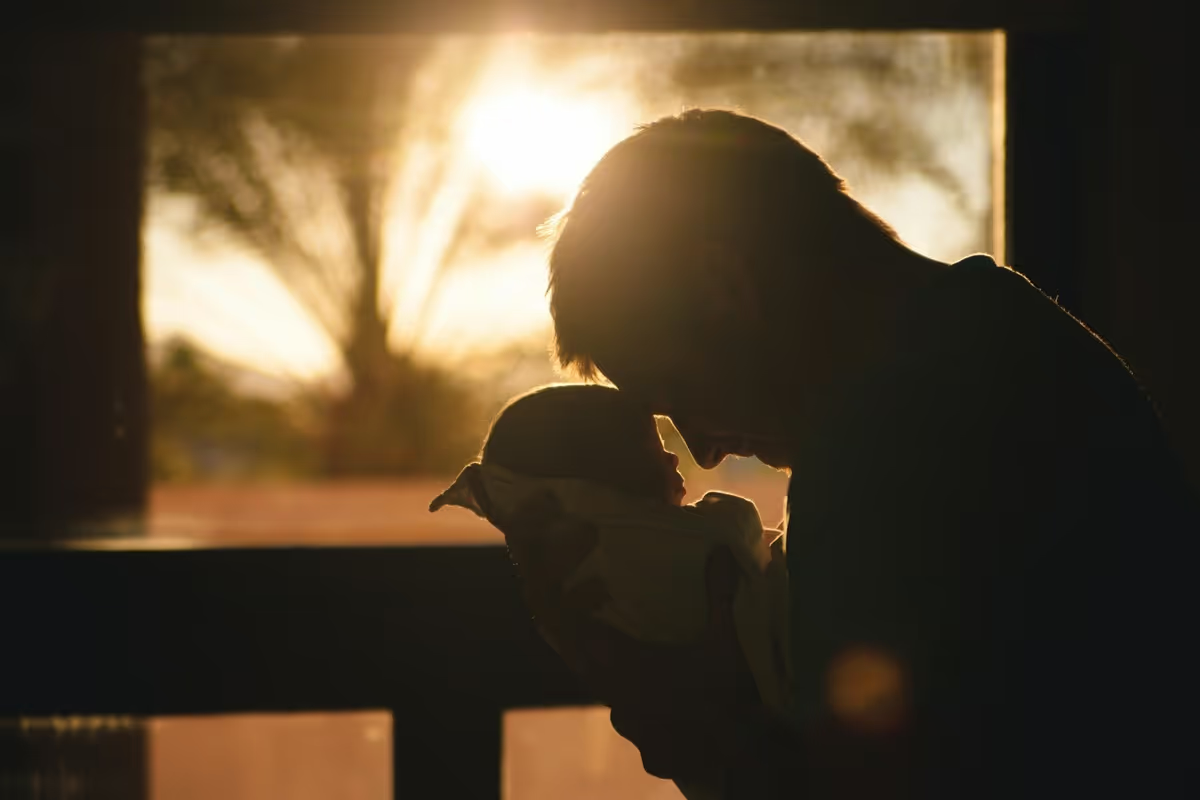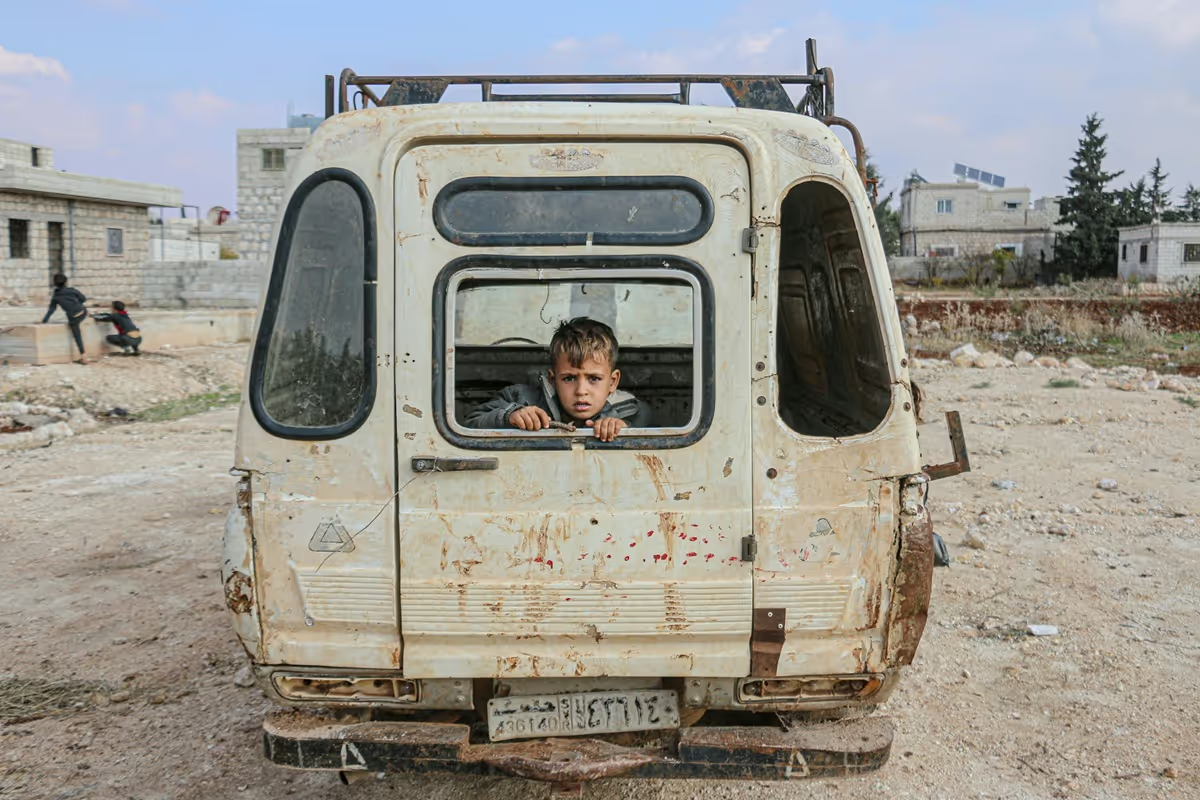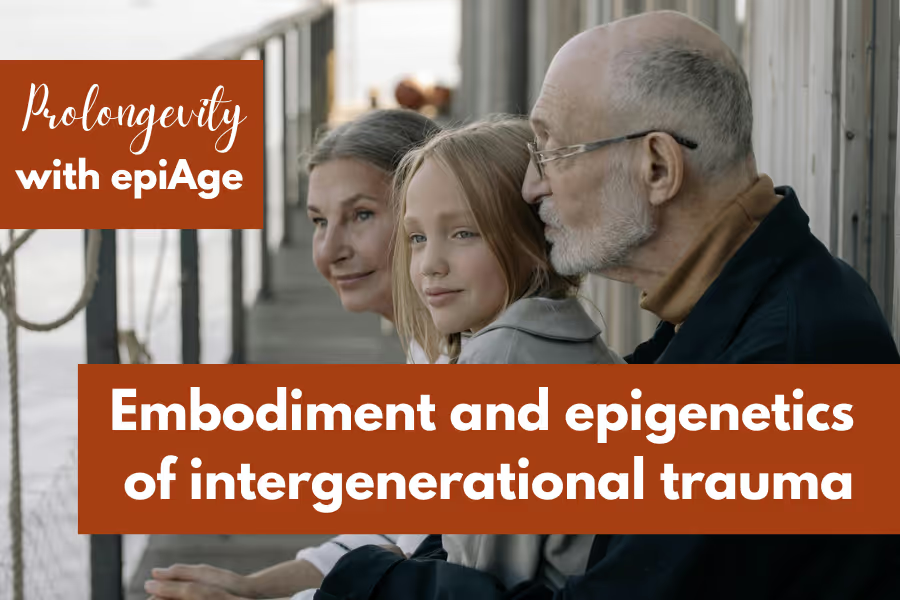Missed part 4 of our “Neuro-mental health” series “Trauma: story, biology and recovery”? Read on here.
Why do we focus so intensively on stress and trauma at epiAge? Because poor neuro-mental health causes ageing to the core of our cells. In fact, trauma not only affects individual health but may, in extreme cases, epigenetically burden further generations.
What if the stress and trauma experienced by your parents or your grandparents had a lot more effect on your physical and mental health than you ever imagined? And what if these effects even overrode your genetic predispositions? Would that make you a “collateral victim” of the hardships they endured? Would you be doomed to battle an enemy you never even met first-hand?
These are just some of the fundamental questions currently rocking the fields of genetics and epigenetics when it comes to acute stress and trauma… So, let’s dive in!
Wouldn’t it be easier to prevent rather than treat the consequences of stress and trauma to ensure healthy and carefree longevity?
This is the provocative question we left you with in our last instalment on the effects of trauma and pathways to healing from it.
Indeed, if anything, our intense foray into the territory of neuro-mental health, has shown that our encounters with stress and trauma can leave potentially lasting and debilitating scars in our overall health and wellbeing.
So, is it a pipe dream to think we could actively avoid all existential stress and trauma?

The short answer is probably “yes” since life is bound to throw us at least a few curve balls. And chances are that we will have precious little influence on the nature of these challenges – from e.g., the death of a loved one to all manner of natural and man-made catastrophes.
But, depending on the intensity, duration and layering of stress and trauma as well as our available resources, we may still be able to influence how drastically these challenges affect us. Hence building up a form of resilience may be an achievable goal.
However, before we discuss this possibility, we should start by stating that, when it comes to stress and trauma, we are unfortunately not all born equal.
We like to think of babies as “clean slates” when they emerge into the world, even if we know that many of them are born into such dire circumstances, that they are bound to be negatively impacted even before they can open their eyes.
Unfortunately, however, babies are anything but clean slates at birth, even if they are born into seemingly harmonious and healthy homes. Indeed, not only are foetuses already permeable to current parental disease and distress, but they also bear the genetic burdens of their parental lineages in the shape of the propensity toward certain weaknesses or illnesses. Furthermore, we know that the way they are born – not to mention the stress of birth itself – can have a lasting impact on their microbiomes and other physiological parameters.
Even more troubling though is the recent discovery that trauma may have an embodied intergenerational dimension. A dimension that goes deeper than the cultural or family narratives, parenting styles or family dynamics that will contribute to shaping the budding self-identity and overall health of a child.

So, apparently, it is not just our immediate entourage or personal experiences that can imprint us with stress or trauma once we are born. We may be born into peaceful and comfortable circumstances and still be unconsciously saddled with a heavy burden of intergenerational trauma.
How is it transmitted then, if not just through the first-hand experiences and behaviours of parents? Is it through the stories of war, deprivation or discrimination passed on through other family members or permeating the culture at large?
In our previous instalment, we discovered that trauma was not just confined to the psyche but had tangible physiological effects encompassing, among others, neurological, endocrine and inflammatory symptoms. Hence, it is not such a leap to imagine that parents with a highly stressed or traumatised physiology may transmit some of its characteristics to their offspring.
This is a question that began to preoccupy researchers in the aftermath of WWII and, increasingly, after the Vietnam War. Dr Rachel Yehuda, a psychiatry and neuroscience professor, was one of the pioneers who began to investigate the embodied experience of trauma as well as its potentially intergenerational dimension in both contexts (for an overview cf. e.g., Yehuda, 2022). Together with other researchers, she was able to show that both veterans and Holocaust survivors often exhibited a disturbance of the hypothalamic-pituitary-adrenal (HPA)-axis – whether expressed in cortisol excess or deficiency, predisposing them to potentially chronic post-traumatics tress disorder (PTSD).
But an even more striking discovery was that, like their parents, many children of Holocaust survivors not only presented with cortisol imbalances but also with mood and anxiety disorders, making them vulnerable to PTSD. This finding was later confirmed by a small study of pregnant women and their offspring exposed to the 9/11 attacks.
In the meantime, research has clearly shown that parental disruption of the HPA axis can lead to a host of health complications in children, from e.g. altered brain structure and gene expression to immune and metabolic dysregulation as well as increased sensitivity to stress.

Hence, intergenerational trauma seems to be clearly connected to hormonal changes. But other embodied pathways have been and are still being explored, such as changes in the quality of germ line cells (that will turn into eggs and sperm) and, last but not least, epigenetics.
When it comes to investigating the embodied transmission of intergenerational trauma, it is epigenetics that has garnered the most attention in recent years.
Why is that?
Epigenetics is arguably one of the most central interfaces in the body, helping it to maintain homeostasis or internal balance while adapting to fluctuating external conditions – be they short-lived or more permanent.
While DNA was long thought to hold the ultimate keys to an individual’s health destiny, the emerging science of epigenetics was able to demonstrate that it is not just inheritance (i.e. nature) that controls overall health but also the environment (i.e. nurture) – thus confirming the intuition of preventivepractitioners throughout the ages.
Put simply, then, epigenetics is the system of biochemical switches (methylation, histone modification, RNAs) that activate or silence the expression of particular genes along a DNA strand.
But what do we mean by “environment” (or nurture) when alluding to epigenetics? In this context, an individual’s environment encompasses not just their lifestyle choices but also their upbringing, family constellation, geophysical habitat, work situation etc. – in sum, their entire bio-psycho-social circumstances.
So, while one’s genetic makeover is a form of relatively stable hardware, slowly evolving over generations, epigenetics represents the more dynamic software. As a gatekeeper, it constantly interacts with and adapts to the environment to ensure that the biological system remains flexible enough to survive and, hopefully, thrive.This interaction is enabled through e.g. neural or endocrine pathways. But this is no one-way mechanism, it is highly interactive and self-regulating. Indeed, just as a person’s epigenetics can steer their neurobiology, their neurobiology will also influence their epigenetics in a constantly evolving dialogue.

Concretely, this means that if you are confronted with particularly challenging circumstances, be they external, such as war or famine, or more internal, such as domestic violence or abuse, epigenetics will help you to initially cope with the stress. It will do so by supporting temporary changes in your metabolism helping you to flee, fight, freeze or adapt.
As a rule, when the threat has passed, the epigenetic tagging of your genes should gradually and naturally dissolve. But if the stress (or trauma) has been particularly brutal or ongoing, what was intended as a temporary adaptation may become so “ingrained” in your epigenetic profile that it can lastingly affect you. Indeed, countless studies have already been published on the long-term epigenetic effects of adverse events in individuals (from childhood to old age) and (minority) communities – highlighting increased disease risk, biological age acceleration and mortality (cf. e.g. Zannas & al., 2015, Jiang & al. 2019 or Smith & al., 2024).
Even more striking and sobering, however, is the fact that these epigenetic effects can be unwittingly passed on to the next generation(s).
Until very recently, the epigenetic dimension of intergenerational trauma proved difficult to demonstrate for a number of reasons.
Initially, it was assumed that epigenetic tagging was completely reprogrammed after conception. While the epigenetics of an embryo does undergo significant restructuring, it is now clear that some of the markings persist – be they in form of methylation, histone modification or RNA activity.
Moreover, the first epigenetic investigations of intergenerational trauma were mainly animal studies, due to the challenge of ethically designing human studies. A famous example was the study conducted at Emory University involving a first generation of mice conditioned to associate the fragrance of cherry blossom with the fear of an electric shock. The second generation, while not directly associating the fragrance with pain, became visibly jumpy when confronted with the scent– despite having been raised by non-conditioned “foster-parents”. And even the third generation was still clearly sensitised to this particular fragrance (Dias & al., 2013).

Seminal human studies on the epigenetics of famine experience were published based on Dutch, Chinese and Swedish cohorts over the past decades (cf. e.g.: De Rooij & al., 2021; Shen & al., 2019; Vågerö & al., 2018). While the studies could all demonstrate intergenerational effects, these effects varied widely according to gender and to when famine exposure occurred (pre-conception, at conception, in utero or later in life) in the first generation. Moreover, even though most effects were negative – highlighting e.g. the severe impact of pre-natal malnutrition, with outcomes such as cardiovascular conditions, obesity and diabetes in middle age – others proved more surprising. In the Swedish studies, which focused on later exposure to famine, not all effects on progeny proved noxious. Some of the children and grandchildren of males exposed to famine pre-puberty seemed to enjoy protective effects against all-cause and especially cancer mortality. However, whether this limited finding highlights the potentially adaptive nature of epigenetic evolution remains a heated debate.
Currently, more human studies are emerging that focus on the intergenerational stress experienced by communities subjected to other sources of acute stress or trauma such as ongoing discrimination or war. A recent study on three generations of Syrian refugees in Jordan is the first to demonstrate that violence could epigenetically affect individuals at three stages – germline, prenatal, and direct. And these epigenetic signatures of violence could persist over subsequent generations (Mulligan & al., 2025).
Despite these promising initial findings, the epigenetic dimension of intergenerational trauma remains a very young field, and many fundamental questions remain open. However, it does open fascinating new perspectives on how we view the interplay of genetics and epigenetics, the origins of non-communicable disease and, last but not least, what we can do about it now – if anything yet.
Because the field of epigenetics is still busy studying the effects of trauma on the human epigenome, it is still difficult to foresee what epigenetic therapies might emerge to counter the effects of trauma at the heart of our cells.
Nevertheless, it is not just wishful thinking to expect that revolutionary trauma interventions could emerge in the very near future. Indeed, research into the epigenetics of ageing and disease has already shown that epigenetic change is not only a dynamic but also a reversible process that can be steered through targeted lifestyle interventions. Even biological ageing caused by stress tends to naturally dissolve once the trigger has disappeared (e.g. Poganik & al., 2023). So, it is quite conceivable that chronic stress or trauma could soon be treated epigenetically.

In the meantime, individuals and communities indirectly exposed to extreme adverse events are not doomed to carry burdens that don’t belong to them and transmit them further. Just like first-hand trauma imprinting, the psychological and physiological effects of inherited trauma can be treated through a variety of both established and emerging therapies – from trauma-informed cognitive behavioural therapy (TI-CBT) to eye movement desensitisation and reprocessing (EMDR) or prolonged exposure (PE), as described in our previous instalment.
For individuals and communities with restricted access (including economic barriers) to state-of-the-art therapies, cultivating a healthy lifestyle (including a balanced diet, movement, quality sleep, mindfulness or stress management) is a crucial first step. In parallel, building resilience is central to ensure a supportive inner and outer environment – be it through positively strengthening identity, building social networks, privileging healthy relationships, creating meaningful and healing rituals or finding new purpose and perspectives.
So, what if resilience, beyond an optimised lifestyle,were the true key to healthy longevity? Discover a roadmap to cultivate resilience in the face of adversity in our next instalment!
++++
Sources and further reading
Ryan, J., Chaudieu, I., Ancelin, M. L., & Saffery, R. (2016). "Biological Underpinnings of Trauma and Post-Traumatic Stress Disorder: Focusing on Genetics and Epigenetics". Epigenomics, 8(11), 1553–1569. doi:10.2217/epi-2016-0083. Online: https://www.tandfonline.com/doi/full/10.2217/epi-2016-0083
“Key findings: Study finds epigenetic changes in children of Holocaust survivors”. U.S. Department of Veteran Affairs. October 20, 2016. Online: https://www.research.va.gov/currents/1016-3.cfm
Yehuda, Rachel. “How Parents’ Trauma Leaves Biological Traces in Children: Adverse experiences can change future generations through epigenetic pathways”. Scientific American, July 1st 2022. Online: https://www.scientificamerican.com/article/how-parents-rsquo-trauma-leaves-biological-traces-in-children/
Jiang S, Postovit L, Cattaneo A, Binder EB, Aitchison KJ. “Epigenetic Modifications in Stress Response Genes Associated with Childhood Trauma”. Front Psychiatry. 2019 Nov 8;10:808. doi: 10.3389/fpsyt.2019.00808. Online: https://www.frontiersin.org/journals/psychiatry/articles/10.3389/fpsyt.2019.00808/full
Kim K, Yaffe K, Rehkopf DH, et al. “Association of Adverse Childhood Experiences With Accelerated Epigenetic Aging in Midlife”. JAMA Netw Open.2023;6(6):e2317987. doi:10.1001/jamanetworkopen.2023.17987. Online: https://jamanetwork.com/journals/jamanetworkopen/fullarticle/2805934
Smith AK, Katrinli S, Cobb DO, et al. “Epigenetic Age Acceleration and Disparities in Posttraumatic Stress in Women in Southeast Louisiana: NIMHD Social Epigenomics Program”. JAMA Netw Open. 2024;7(7):e2421884. doi:10.1001/jamanetworkopen.2024.21884. Online: https://jamanetwork.com/journals/jamanetworkopen/fullarticle/2821613
Buckley, L., Turiano, N., Sesker, A., Butler, M., & O'Súilleabháin, P. S. (2024).“Lifetime trauma and mortality risk: A systematic review”. Health Psychology, 43(4), 280–288. doi:10.1037/hea0001343. Online: https://psycnet.apa.org/fulltext/2024-42615-001.html
Lim S, Nzegwu D, Wright ML. "The Impact of Psychosocial Stress from Life Trauma and Racial Discrimination on Epigenetic Aging—A Systematic Review". Biological Research For Nursing. 2022;24(2):202-215. doi:10.1177/10998004211060561. Online: https://journals.sagepub.com/doi/10.1177/10998004211060561
Zeming Wu, Jing Qu, Weiqi Zhang, Guang-Hui Liu. “Stress, epigenetics, and aging: Unraveling the intricate crosstalk”. Molecular Cell, Volume 84, Issue 1, 2024,34-54. doi:10.1016/j.molcel.2023.10.006. Online: https://www.sciencedirect.com/science/article/pii/S1097276523008092
Zannas, A.S., Arloth, J., Carrillo-Roa, T. et al. “Lifetime stress accelerates epigenetic aging in an urban, African American cohort: relevance of glucocorticoid signaling”. Genome Biol 16, 266 (2015).doi:10.1186/s13059-015-0828-5. Online: https://genomebiology.biomedcentral.com/articles/10.1186/s13059-015-0828-5
Henriques, Martha. “Can the legacy of trauma be passed down the generations?”. BBC. 26 March 2019. Online: https://www.bbc.com/future/article/20190326-what-is-epigenetics
Dias, B., Ressler, K. “Parental olfactory experience influences behavior and neuralstructure in subsequent generations”. Nat Neurosci 17, 89–96 (2014). doi:10.1038/nn.3594. Online: https://www.nature.com/articles/nn.3594
De Rooij, S. R., Bleker, L. S., Painter, R. C., Ravelli, A. C., & Roseboom, T. J. (2021). “Lessons learned from 25 Years of Research into Long term Consequences of Prenatal Exposure to the Dutch famine 1944–45: The Dutch famine Birth Cohort”. International Journal of Environmental Health Research, 32(7),1432–1446. doi:10.1080/09603123.2021.1888894. Online: https://www.tandfonline.com/doi/full/10.1080/09603123.2021.1888894
Shen L, Li C, Wang Z, Zhang R, Shen Y, Miles T, Wei J, Zou Z. “Early-life exposure to severe famine is associated with higher methylation level in the IGF2 gene and higher total cholesterol in late adulthood: the Genomic Research of the Chinese Famine (GRECF) study”. Clin Epigenetics. 2019 Jun 10;11(1):88. doi:10.1186/s13148-019-0676-3. Online: https://pmc.ncbi.nlm.nih.gov/articles/PMC6558811/
Vågerö, D., Pinger, P.R., Aronsson, V. et al. “Paternal grandfather’s access to food predicts all-cause and cancer mortality in grandsons”. Nat Commun 9, 5124 (2018). doi:10.1038/s41467-018-07617-9. Online: https://www.nature.com/articles/s41467-018-07617-9
González-Rodríguez, P., Füllgrabe, J. & Joseph, B. “The hunger strikes back: an epigenetic memory for autophagy”. Cell Death Differ 30, 1404–1415 (2023). doi:10.1038/s41418-023-01159-4.Online: https://www.nature.com/articles/s41418-023-01159-4
Cummings, Mike. “Violent experiences alter the genome in ways that persist for generations”. YaleNews, Mar 6, 2025. Online: https://news.yale.edu/2025/03/06/violent-experiences-alter-genome-ways-persist-generations
Mulligan, C.J., Quinn, E.B., Hamadmad, D. et al. “Epigenetic signatures of intergenerational exposure to violence in three generations of Syrian refugees”. Sci Rep 15, 5945 (2025). doi:10.1038/s41598-025-89818-z. Online : https://www.nature.com/articles/s41598-025-89818-z
Ali Jawaid, Martin Roszkowski, Isabelle M. Mansuy. “Chapter Twelve - Transgenerational Epigenetics of Traumatic Stress”. Progress in Molecular Biology and Translational Science. Ed. Bart P.F. Rutten. Cambridge (MA): Academic Press. Volume 158, 2018, Pages 273-298. doi:10.1016/bs.pmbts.2018.03.003. Online: https://www.sciencedirect.com/science/article/abs/pii/S187711731830053X?via%3Dihub
Jesse R. Poganik, Bohan Zhang, Gurpreet S. Baht, Alexander Tyshkovskiy, Amy Deik, Csaba Kerepesi, Sun Hee Yim, Ake T. Lu, Amin Haghani, Tong Gong, Anna M. Hedman,Ellika Andolf, Göran Pershagen, Catarina Almqvist, Clary B. Clish, Steve Horvath, James P. White, Vadim N. Gladyshev, “Biological age is increased by stress and restored upon recovery”, Cell Metabolism, Volume 35, Issue 5,2023, 807-820.e5, doi:10.1016/j.cmet.2023.03.015. Online: https://www.sciencedirect.com/science/article/abs/pii/S1550413123000931
Divya Mehta, Dagmar Bruenig, John Pierce, Anita Sathyanarayanan, Rachel Stringfellow, Olivia Miller, Amy B. Mullens, Jane Shakespeare-Finch. “Recalibrating the epigenetic clock after exposure to trauma: The role of risk and protective psychosocial factors”. Journal of Psychiatric Research, Volume 149,2022, 374-381. doi:10.1016/j.jpsychires.2021.11.026. Online: https://www.sciencedirect.com/science/article/abs/pii/S0022395621006750
Illustrations
cottonbro / pexels & epiAge
Yaroslav Shuraev / pexels
Josh Willink / pexels
Ahmed Akacha / pexels
Giantas Paragus / pexels
Prosper Mbemba Koutihou / pexels
cottonbro / pexels
 Back to all posts
Back to all posts